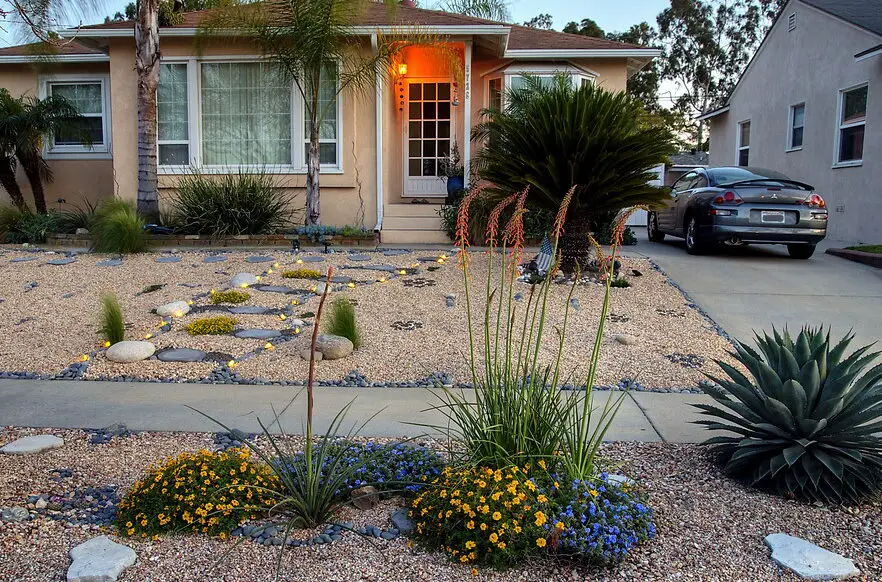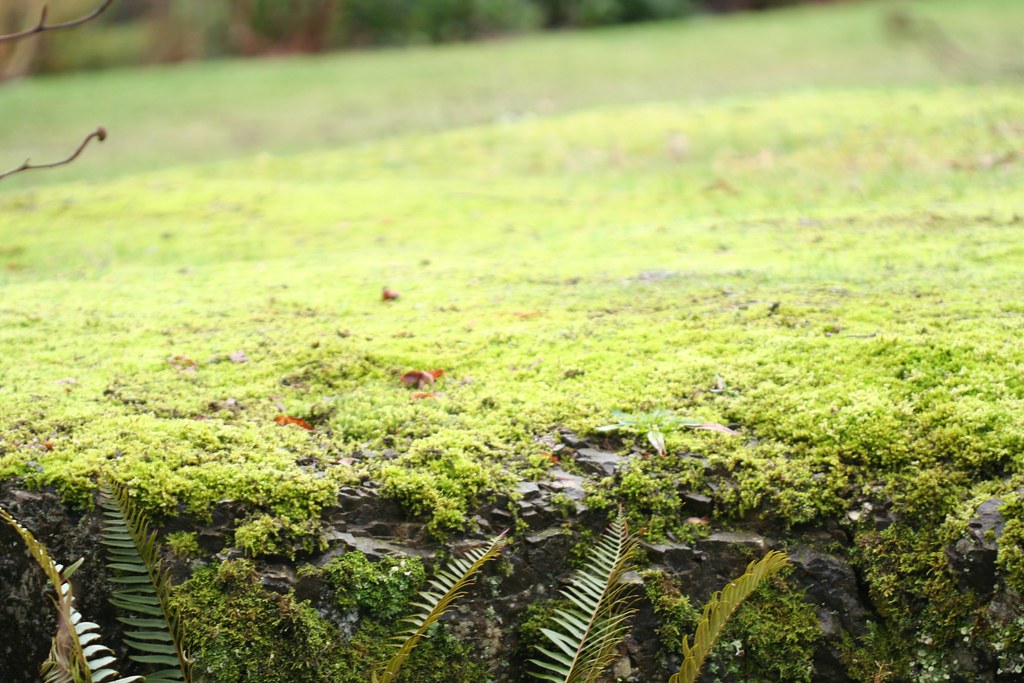For decades, the traditional grass lawn has been a staple of American landscaping, but a growing number of homeowners are opting for alternatives. Factors like climate change, water restrictions, and high maintenance costs have made grass-free yards an attractive option. From drought-resistant gardens to artificial turf and decorative gravel, these alternatives offer beauty with significantly less upkeep. As the no-grass movement gains momentum, many homeowners’ associations (HOAs) are beginning to adapt their rules to reflect the shift toward sustainable landscaping.
1. The Rise of Drought-Friendly Landscaping

With increasing drought conditions across the country, many homeowners are turning to xeriscaping as a water-efficient alternative to traditional grass. This landscaping approach prioritizes drought-tolerant plants, decorative stones, and mulch to create a visually appealing yet low-maintenance yard. Succulents, native plants, and ornamental grasses replace the need for constant watering, making it an environmentally responsible choice. These landscapes not only conserve water but also reduce the need for fertilizers and pesticides, which can harm local ecosystems.
The shift toward drought-friendly landscaping is being embraced by cities and communities that previously mandated traditional lawns. Some municipalities now offer incentives for homeowners who replace their grass with more sustainable options. According to The New York Times, cities like Las Vegas and Los Angeles have introduced “cash-for-grass” programs that pay residents to remove their turf. As more regions experience water shortages, this trend is expected to become the new norm in residential landscaping.
2. Artificial Turf: A Low-Maintenance Alternative

For homeowners who want the look of grass without the hassle, artificial turf has become a popular solution. Modern synthetic grass is designed to be soft, durable, and realistic, providing a lush green appearance year-round. Unlike traditional lawns, it requires no watering, mowing, or fertilizing, making it an ideal option for those seeking convenience. Additionally, artificial turf can withstand heavy foot traffic, making it a great choice for families with children and pets.
Despite its benefits, artificial turf has faced resistance in some HOA-governed communities due to concerns about aesthetics and heat absorption. However, as demand for low-maintenance landscaping grows, many HOAs are beginning to revise their policies. According to Forbes, several homeowner associations in Arizona and California have recently lifted bans on artificial turf to accommodate changing environmental concerns. With improved technology and better regulations, synthetic lawns are becoming a more widely accepted alternative to natural grass.
3. Gravel and Hardscaping for a Sleek, Modern Look

Gravel gardens and hardscaping elements are redefining what a beautiful front yard can look like. Homeowners are replacing grass with crushed stone, pavers, and decorative rock formations to create stylish, low-maintenance landscapes. This approach not only eliminates the need for watering but also reduces the time and effort spent on lawn care. By incorporating drought-resistant plants, outdoor seating areas, and artistic stone designs, these yards can be both practical and visually striking.
While some HOAs were once strict about requiring grass, many are loosening their restrictions to allow for creative hardscaping designs. In regions with extreme weather conditions, homeowners are finding that gravel and pavers hold up better than traditional turf. Better Homes & Gardens reports that modern landscaping trends favor sustainable materials and minimalist designs, influencing HOAs to revise outdated lawn requirements. As more communities embrace this aesthetic, no-grass yards are becoming a mainstream choice.
4. Native Plant Lawns: Supporting Biodiversity

Replacing grass with native plants offers a natural way to maintain a lush, green yard while benefiting local ecosystems. Native plant lawns require minimal water and are naturally resistant to pests, eliminating the need for chemical treatments. These lawns also attract pollinators like bees and butterflies, contributing to healthier local biodiversity. By mimicking natural landscapes, homeowners can create vibrant yards that thrive with little intervention.
Many HOAs that once mandated turfgrass are now approving native plant landscaping due to its environmental benefits. In some cases, state and local laws are even overriding HOA regulations to encourage sustainable practices. According to National Geographic, several states, including Florida and Texas, have passed laws preventing HOAs from banning native plant gardens. As more communities recognize the advantages of these eco-friendly landscapes, the shift away from traditional grass continues to grow.
5. Wildflower Meadows: A Colorful Alternative

Wildflower meadows are gaining popularity as a vibrant and eco-friendly alternative to traditional lawns. Instead of uniform green grass, these yards burst with seasonal blooms that attract pollinators and create a natural, untamed beauty. Wildflowers require far less maintenance, as they don’t need frequent mowing or watering once established. Homeowners who opt for wildflower lawns also benefit from increased biodiversity and a yard that changes beautifully throughout the year.
Many homeowners are turning to wildflower meadows as a way to embrace a more natural landscape while reducing their environmental impact. These yards can be designed with native flower species to ensure they thrive in specific climates. They also offer a stunning visual appeal that sets them apart from traditional lawns. As more people embrace organic and sustainable gardening, wildflower yards are becoming a preferred choice for low-maintenance, eco-conscious landscaping.
6. Moss Lawns: A Lush, Soft Alternative

For those seeking a green ground cover without the hassle of mowing, moss lawns are an excellent option. Moss thrives in shady areas with minimal soil requirements, creating a soft, velvety carpet that stays lush throughout the year. Unlike traditional grass, moss does not require fertilizers, pesticides, or excessive watering, making it a truly low-maintenance choice. Homeowners who struggle with dry, compacted, or rocky soil often find moss to be an ideal solution.
Moss lawns provide a serene, natural aesthetic that blends beautifully with wooded landscapes and garden paths. Their ability to retain moisture makes them especially beneficial in regions with inconsistent rainfall. They also absorb noise and provide a cooling effect, making them a practical choice for both urban and suburban settings. As more homeowners move toward sustainable landscaping, moss lawns are becoming a sought-after alternative to conventional grass.
7. Edible Gardens: Beauty with a Purpose

Transforming a lawn into an edible garden is an increasingly popular choice for homeowners who want to maximize their outdoor space. Raised beds, fruit trees, herb gardens, and berry bushes create a lush, productive landscape that provides fresh food year-round. These gardens can be designed to be as aesthetically pleasing as they are functional, with creative layouts and companion planting techniques. They also reduce grocery bills and promote a healthier, homegrown lifestyle.
An edible garden doesn’t have to be purely utilitarian—it can be a work of art. Thoughtful placement of plants, decorative trellises, and pathways can create a visually stunning design while maintaining practical use. Homeowners enjoy the added benefit of reducing their environmental impact by growing their own food. As more people look for ways to merge sustainability with beauty, edible gardens are proving to be an attractive alternative to traditional lawns.
8. Clover Lawns: A Resilient and Eco-Friendly Option

Clover lawns are an excellent no-grass alternative that provides a lush, green look with minimal effort. Unlike traditional turf, clover is naturally drought-resistant, thrives in poor soil, and requires little to no mowing. It also enriches the soil by fixing nitrogen, reducing the need for fertilizers. Homeowners who switch to clover lawns often find them to be softer underfoot and more resistant to pests.
Clover’s ability to self-seed and spread quickly makes it a great option for those looking for a low-maintenance yet beautiful yard. Its delicate white or pink flowers add a charming touch, attracting pollinators while keeping weeds at bay. Some homeowners opt for a mix of clover and native grasses to create a more diverse, sustainable lawn. As the push for eco-friendly landscaping grows, clover lawns are becoming a practical and visually appealing alternative.
9. Decorative Rock Gardens: A Modern, Low-Water Solution

Rock gardens offer a sleek, modern take on traditional landscaping while eliminating the need for grass. By incorporating decorative stones, boulders, and drought-resistant plants, these yards create a striking aesthetic with almost zero maintenance. Homeowners can customize their rock gardens with different colors, textures, and shapes to create a unique outdoor space. This option is particularly popular in desert climates, where water conservation is essential.
Aside from their visual appeal, rock gardens help prevent soil erosion and reduce the presence of pests that thrive in grassy lawns. They also provide an ideal setting for succulents, cacti, and other hardy plants that require little upkeep. Many homeowners find rock gardens to be a stylish and practical way to enhance their outdoor spaces. As landscaping trends shift toward sustainability, rock gardens are becoming a go-to option for those seeking a low-maintenance yet visually stunning yard.
